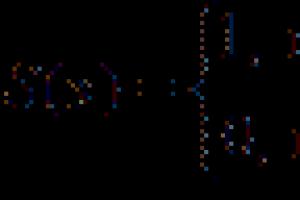Became popular in foreign countries expanded clay concrete blocks are increasingly being used in construction low-rise buildings in the vastness of our country. Have you been dreaming of your own private home away from the noisy city? Today is the time to make your dream come true. In this article we will tell you how to build a house from expanded clay blocks with your own hands in a short time, with minimum costs, both material and physical.
Application of expanded clay concrete
A house made of expanded clay blocks does not need special care and different long periods operation. For the construction of summer houses or country houses Multi-slot and solid expanded clay concrete are mainly used. If you are planning to build cottage with a light wooden ceiling, it is better to raise the walls from solid blocks. For buildings with two or more floors, both types of blocks are used.

Multi-slot blocks have grooves and ridges on both sides, which allows installation along vertical seams without the use of mortar. This type of masonry is called a butt joint and is designed to improve the thermal conductivity of the wall by reducing the number of cold bridges.
The design of your future home should be ordered from a highly qualified specialist. When discussing various nuances, you should pay special attention to the fact that the house will be built from expanded clay blocks. A well-drafted project indicating all dimensions will help to avoid various unforeseen situations that worsen the quality of the structure.
Advantages of expanded clay blocks over the use of other building materials:
- Ecological cleanliness.
- Resistance of blocks to various external influences.
- Increased technology.
- Low water absorption rates.
- Expanded clay concrete has excellent thermal insulation properties.
- The small mass of the products does not require a powerful foundation.
Calculation of the required number of blocks

You can save construction costs if you know how to calculate expanded clay blocks for a house. To make the most accurate calculations, you need a house design. From it you can determine the dimensions of the building. You should sum up the length of the outer and inner load-bearing walls. The result is the length of all the walls of the house, which must be multiplied by the height of the premises. To continue the calculation, you need to know the thickness of the designed walls and the dimensions of the blocks used for construction. The last figure obtained in the calculations is multiplied by the designed wall thickness. The result is the volume of all the walls of the house.
When purchasing expanded clay blocks, start from the volume received and be sure to add up to 5% to it for unforeseen situations. This could be a fight or a marriage of individual elements.
Construction technology
Let's consider the technology of building a house step by step.
Foundation

If the project provides basement, the foundation must be built from concrete blocks. For an ordinary house laid from expanded clay blocks strip foundation.
- The construction site should be thoroughly cleared of debris and leveled.
- Dig a pit, the depth of which depends on the type of soil and level groundwater in the construction area.
- Place a cushion of coarse sand and crushed stone in layers of 30 cm at the bottom of the pit.
- Install the reinforcement frame and formwork from wooden panels.
- Using a concrete mixer, prepare a solution from fine crushed stone, sand, cement and water. Pour the foundation.
When laying the foundation for a house, it is necessary to immediately lay pipes for water supply and drainage. Don't forget about the device ventilation holes along the entire perimeter of the building.
The foundation should be left to harden for at least two weeks, and preferably three months. During this time, the foundation will sag under its own weight, which will improve the quality of the construction of the entire building. To prevent moisture from entering the basement and foundation, you need to install high-quality waterproofing.

For ease of work, stretch the cord from corner to other corner. Start laying the walls from the corner. After placing the corner block on the base, check its vertical and horizontal orientation. Having completed the laying of the first row, begin laying the second. Be sure to bandage between rows.
The height of the seam between the blocks should be 10 mm. There should be no empty gaps between the blocks, so it is necessary to carefully coat all seams with the solution.
If you want your home to be warm and cozy, we recommend that, along with laying expanded clay blocks, parallel laying of insulation and external decorative element. This can be facing bricks, special blocks or other materials.
When using brick for cladding a building, it is necessary to tie the inner and outer layers of the masonry with fiberglass rods or mesh. Special attention pay attention to the laying of blocks forming window and door openings.
Check each row of masonry horizontally and vertically.
Reinforcing the walls every four rows will help give greater rigidity to the building structure. To do this you will need reinforcement or masonry mesh. Having completed the laying of the walls, you need to install a reinforcing belt made of reinforced concrete or ordinary brick on top.
Roof construction
The better the quality of the rafter system, the more reliable the roof structure will be. Expanded clay blocks should also be used for laying gables. Do not forget about the need to carry out thermal insulation and waterproofing works before installation roofing material. Particular attention should be paid to the installation of chimneys.
A house made of expanded clay blocks can be faced with a variety of materials. The cheapest way is to finish the building with sand and cement plaster. You can make a regular one or decorative plaster and paint the building any color you like.

It will look aesthetically pleasing and noble a natural stone. The most important thing is that its characteristics include excellent frost resistance.
Economical cladding - thermal panels made of polyurethane foam and clinker tiles. Excellent environmentally friendly material perfectly retains heat in frost and life-giving coolness in hot weather.
So we told you how to build a house from expanded clay blocks to make it warm and reliable. About how to do internal lining buildings made of expanded clay blocks, installation floor coverings, rafter system, supply of communication systems and other works you can read in our next articles.
Video
We bring to your attention a video in which you will learn how to correctly lay the corner of a house made of expanded clay concrete.
Company " Summer Season» designs and builds houses made of expanded clay concrete on a turnkey basis. We build light, durable and warm cottages for seasonal and permanent residence for individual and ready-made projects. The company performs the entire range of work - from preparing documentation to removing waste after putting the house into operation.
Expanded clay concrete block is a molded cellular concrete obtained by mixing Portland cement, sand and expanded clay of small fractions (granules up to 5 mm). Thanks to semi-dry pressing technology, a strong, frost-resistant and durable material is formed. wall material, having low water absorption and thermal conductivity. It is environmentally friendly because it does not contain aggressive impurities (for example, lime or aluminum).
Due to the increased moisture resistance, when building a house from expanded clay concrete blocks, there is no need to apply plaster that reduces moisture absorption. Laying is done using a thin layer of ordinary cement mortar. When carrying out work there is no need to use special adhesive mixtures.
Order turnkey house construction
The website of the Dachny Season company presents a large selection of house designs made from expanded clay concrete blocks. The catalog contains various options complete sets, floor plans, photos of finished cottages built in Moscow and the Moscow region. You can also choose additional options, for example, interior and exterior decoration, installation of gutters, wiring of internal utility networks and immediately calculate the turnkey price. The basic package does not include balconies, terraces and porches.
Advantages of cooperation with the company “Dachny Season”:
- internal redevelopment - FREE,
- staged payment - 1% - 14% - 20% - 20% - 20% - 20% - 5%,
- timber from the direct manufacturer,
- technical Supervision,
- 15 years of experience in the field of low-rise construction,
- free delivery of materials within 100 km from the Moscow Ring Road,
- Warranty for all types of work - 7 years.
You can also inexpensively order an individual design of a house made of expanded clay concrete from us or separately purchase any project from the catalog without completing construction work. For consultation, please call: +7 (499) 650–50–18.
Modern construction technologies abound in variety of choices. Expanded clay concrete structures are one of the relatively new projects for our country. The characteristics of blocks made of this material, as well as reviews from builders and owners of such houses, speak of the unique properties of expanded clay concrete. The article will tell you with the help of photos about its pros and cons.
What is expanded clay concrete
Building a house with your own hands is an opportunity to solve the housing problem for less money, compared to ready-made new housing. On your own plot of land you are your own boss, architect and builder, so you can invest your energy and resources a little or a large share, planning according to your taste future home and the area around it. It is clear that in this case everyone wants to spend little without losing quality, durability and safety. One of the materials to help people who like to do things “conscientiously” is expanded clay concrete blocks.

Expanded clay concrete
Expanded clay concrete is several decades old, but it has only recently begun to be actively used in construction. This wave material can be classified as environmentally friendly. It is made simply: low-melting clay is foamed and fired in a special way, which then cools naturally and turns into expanded clay - granular stones the size of a ping-pong ball. Expanded clay is characterized by high density and compressive strength and, at the same time, lightness. The granules serve as an aggregate during the production of concrete blocks, instead of traditional stones. The average density of blocks is 400-1800 kg/m3. This recipe turned out to be a wonderful solution, which has a lot of advantages during construction.
Advantages of expanded clay concrete materials
Traditional materials for building a house (brick and concrete cinder blocks) may fall into oblivion. Technologies today allow the blocks to be lighter, and the construction itself proceeds faster without loss of reliability. Expanded clay concrete blocks are used in the construction of various types of structures, incl. residential buildings with several floors: both for load-bearing and for other types of walls.
Advice. Builders call this material an ideal combination of the positive characteristics of wood and stone, which is why it is increasingly gaining popularity in the construction of garages, bathhouses, plinths or roofing.
Let's highlight main advantages of expanded clay concrete:
- the material does not rust, does not rot, and is resistant to temperature changes and fire;
- retains heat better than concrete;
- the porous structure of the material allows it to “breathe” without loss of heat, and also removes excess moisture and even steam.
- provides better sound insulation;
- the lightness of expanded clay concrete blocks ensures less load on the foundation and, as a result, a longer lifespan of the structure without shrinkage and deformation;
- the weight of the building material also speeds up the installation of the house several times and allows for the transportation of blocks at a lower cost. In addition, less mortar will be needed for construction;
- expanded clay is environmentally friendly and resistant to chemical reactions;
- allows the construction of buildings from 3 floors and above without reinforcing structures, unlike foam concrete and aerated concrete;
- the price of an expanded clay concrete block per 1 m3 is less than that of a brick;
- the building material does not accumulate dangerous radiation and does not transmit it.

The material has many advantages
Disadvantages of expanded clay concrete building materials
Of course, the material also has negative qualities:
- Due to porosity, expanded clay concrete blocks are inferior to brick in strength, density and resistance to some negative factors, but not critically. Therefore, the design of a house requires careful calculation so as not to harm the positive properties of the material.
- A wall made of expanded clay concrete will require additional finishing - the appearance of the blocks is unpresentable. However, houses made of expanded clay without finishing are gradually becoming fashionable.
- Air exchange is still inferior to a brick wall.
- Formation of “cold bridges”. There are simple ways to prevent them during construction, but they will require additional costs.
- The properties of the material do not negate the possible need for additional hydro- and thermal insulation.
- The blocks are not easy to cut due to their abrasiveness characteristics. In the process, it is easy to get uneven edges or cracks and, as a result, gaps in the wall.
- Not every fastener will hold securely in a wall made of expanded clay concrete: for example, a dowel can, but an anchor bolt can “sink.” However, everything depends on the characteristics of a particular block.
Attention! There are a lot of low-quality building materials made from expanded clay concrete on the market, with violations of geometry and density standards.
Expanded clay concrete blocks in practice
The main size of the expanded clay concrete block is 390 x 190 x 188 mm (+/- 5-10 mm). This is more than a regular one-and-a-half brick. There are variations of the block in the line of models: depending on the purpose, it can be shorter, lower or narrower. There are also foundation modules with recesses for forming monolithic belt. Besides, wall block can be solid or hollow (30% or 40%) to increase frost resistance.
The experience of builders and owners of houses made of expanded clay concrete can be summarized into the main theses:
- The project does not require special design solutions and in-depth knowledge of subtleties and tricks. The blocks are easy to install. An ordinary private developer can build walls on his own.

- The geometry of building materials allows for simple transportation and eliminates the need to use special equipment.
- Calculating the strength of your home is a key step in the first stage of construction. Expanded clay concrete requires care in this process.
- The material is also effective in internal structures: load-bearing partitions and ceilings.
- Two-layer structures made of lightweight expanded clay concrete and structural concrete have shown themselves to be the best in structures built in earthquake-prone areas or on subsiding soils.
- The blocks combine well with small-piece materials, window and door openings, metal structures and reinforced concrete products.
Our country is just getting acquainted with expanded clay concrete. The number of buildings using the material does not exceed 10%; in European countries this figure reaches 40%. At the same time, it is likely that construction will develop in the expanded clay direction in the coming years.
Advantages of expanded clay blocks: video
House made of expanded clay concrete blocks: photo







Since the time when expanded clay appeared, no significant changes have occurred in the technology of its production. Porous blocks made using this material are also highly environmentally friendly and are relatively cheap. In buildings constructed from these products, it is easy to “breathe”; and a house made of expanded clay concrete blocks, which in terms of thermal insulation characteristics is not inferior to a structure made of gas or foam concrete, can be built even by a novice builder.
Main types of expanded clay concrete blocks
Expanded clay concrete blocks (according to GOST, they are regulated like stones) are produced in different grades, indicating their compressive strength. Depending on the volume of expanded clay, the density of the blocks varies from 350 to 1800 kg/m³. The less expanded clay in a product, the denser, heavier it is and its thermal conductivity coefficient is higher, that is, the material is durable, but not very “warm”. A high content of porous expanded clay significantly reduces the density of the material and its strength, but gives it good thermal insulation characteristics. Therefore, only after understanding the purpose of stones and their scope of application, you will be able to understand what products you will need to erect a building from expanded clay concrete blocks with your own hands. Based on density, all expanded clay concrete blocks are divided into the following types:
- Thermal insulation products with a density from 350 to 700 kg/m³: used for laying the thermal insulation layer.
Important! Thermal insulation blocks cannot be used for the construction of load-bearing walls.
- Mixed-use blocks with a density from 700 to 1400 kg/m³: used for construction wall panels And interior partitions that are not subject to heavy loads.
- Structural blocks made of expanded clay concrete, the density of which varies from 1400 to 1800 kg/m³ (they are quite heavy). Used for the construction of load-bearing structures.
Advice! A structure made from products of this type is durable, but “cold”, so plan how to insulate a house built from expanded clay concrete blocks.

Conclusion: a material with low density has a low thermal conductivity coefficient, but its strength leaves much to be desired; High-density material has good compressive strength, but when using it when building a house, it is necessary to provide insulation.
In the construction market, expanded clay concrete products are presented in two varieties: hollow and solid. Solid ones are highly durable and are used for the construction of load-bearing walls and structures that can withstand heavy loads. Hollow blocks are not very strong, but have good heat-saving characteristics. They are used for the construction internal partitions, and sometimes as an additional heat-insulating or sound-proofing layer.
To facilitate the construction of a building such as a house made of expanded clay concrete, reduce the amount of mortar and prevent the formation of cold bridges, products with a tongue-and-groove system are often used.
Calculation of the required number of blocks
How to calculate required amount blocks for building a house from expanded clay concrete with your own hands? Very simple. The calculation is made without taking into account the thickness of the masonry joint. Initial data: width of the front wall - 6 m, length of the side wall - 9 m, height at the corner - 3 m, height at the ridge - 7 m, we lay the wall in half a block.
We calculate the total area of the walls: S(total) = 6×3×2 + 9×3×2 + 4×3×2 = 36 + 54 + 24 = 114 m².

Determining the area window openings(considering that the width of one window is 1.4 m; height - 1.2 m; quantity - 4 pieces): S (windows) = 1.4 × 1.2 × 4 = 6.72 m².
We determine the area of the doorway (taking into account that the width of the doorway is 1.2 m and the height is 2.2 m): S(doorway) = 1.2 × 2.2 = 2.64 m².
Wall area (excluding windows and doorways): S(walls) = S(total) - S(windows) - S(doorway) = 114 - 6.72 - 2.64 = 104.64 m².
Expanded clay block measuring 0.2 m × 0.2 m × 0.4 m has an area: S(block) = 0.2 × 0.4 = 0.08 m².
Number of blocks required for masonry: N = S(walls) : S(blocks) = 104.64: 0.08 = 1308 pieces (this is the number of blocks needed for our construction).
The amount of material will decrease if the thickness of the masonry joint is taken into account in the calculation (about 15 mm), but it is better not to do this (let there be a small margin). Calculation of the number of products for internal partitions is done in a similar way.
Technology of building a house from expanded clay concrete
If you are building an expanded clay concrete house, follow the recommended technology and you will succeed.
Foundation
Professionals say that a strip foundation is most suitable for building a house made of expanded clay concrete blocks (by the way, just like a monolithic house). The technology for its arrangement is simple, so you can easily make the foundation needed for your house from expanded clay concrete blocks yourself. We carry out the following work:
- we dig a trench under the foundation (the width exceeds the width of the wall by 10-15 cm, and the depth is 50 cm);
- Place a sand cushion on the bottom (height – 15 cm);
- moisten the sand generously with water and tamp;
- pour a layer of crushed stone (15 cm high);
- compact the crushed stone;
- we arrange a waterproofing layer (for example, roofing felt);
- we install the formwork, which must be waterproofed;
- We make a reinforcing frame inside the formwork;
- pour concrete;
- after 5 days we remove formwork, top and side surfaces We waterproof the foundation with mastic and roofing felt;
- fill the cavities between the foundation and the trench with sand;
- we take a break for 1-3 months so that the foundation settles;
- We are starting to lay the walls.

We lay expanded clay concrete wall blocks
The masonry algorithm looks like this:
- We lay roofing material on the foundation in 2-3 layers (coat each layer with mastic);
- place 2 blocks on the solution from each corner;

- along the entire perimeter we stretch a cord between the corner blocks, along which we align the laying of expanded clay concrete products of the first row;
- we check the masonry with a level, adjust the position of each block using a rubber mallet;
- we take a break for 1 day so that the row of masonry settles;
- We build subsequent rows in a checkerboard pattern, starting from the corner (we lay no more than 3-4 rows per day);
- before laying floors between floors and rafter system We install reinforcing belts on the roofs.
Important! Check the quality of the masonry as often as possible using a level and plumb line.
Options for laying standard blocks depending on the desired thickness:

Insulation
To insulate houses made of expanded clay concrete blocks from the outside, they use different materials: mineral wool with a foil layer (this material provides vapor barrier aluminium foil), glass wool, polystyrene foam, penoplex.
Important! To increase the service life of the thermal insulation layer, it is necessary to install a vapor barrier on top of it.
The most effective and available material counts mineral wool with a foil layer (available in the form of dense and durable slabs), it is ideally suited for such a “breathable” material as expanded clay concrete.
The technology for laying the thermal insulation layer is quite simple:
- we clean the outer walls from dust and treat them with a primer for exterior work;
- mix the glue according to the instructions indicated on the package;
- apply glue along the entire perimeter of the mineral wool sheet and additionally in the middle;
- glue the slabs to the wall in a checkerboard pattern, starting from the bottom of one of the corners;
- after 1 day, we secure the glued mineral slabs with plastic dowels (“umbrellas”);
- We install the reinforcing layer (special facade fiberglass mesh): we press it into the layer of applied plaster glue using a wide spatula;
- We lay another layer of special glue on the dried reinforcing layer and cover it with some kind of facade decorative plaster;
- After final drying, we paint.

In custody
If you decide to build and you are capable of building a house with your own hands, follow our recommendations and use expanded clay concrete products. As a result, you will receive housing with a favorable microclimate.
When designing country house and the choice of material for walls, first of all, lightweight and budget-friendly masonry products with high insulating properties are considered. These conditions are fully met by blocks made of expanded clay concrete, the average cost of 1 m3 is 3,000 rubles, the final prices for their laying are 2-3 times higher than bricks. The dimensions and weight allow you to carry out the work on your own and reduce costs by 1/3 compared to paying for the services of the relevant companies, but drawing up the project is usually entrusted to professionals. The finished documentation includes the main dimensions of the house and individual designs, results of calculation of building materials, masonry schemes, reinforcement, location of floors and roofing systems.
The blocks are produced by vibrocompression; the main components are Portland cement, sand and baked clay granules; after steaming and strengthening, they are completely suitable for masonry. For the construction of houses, both hollow and large-slot products are used; to enhance the load-bearing capacity of the structure, they are reinforced. The benefits include:
1. Lightness, allowing to reduce the load on the foundation of the house. For the construction of load-bearing walls, elements with a specific gravity in the range of 700-1200 kg/m3 are used; in this regard, expanded clay concrete is inferior to foam blocks and gas silicate, but undoubtedly outperforms brick and concrete.
2. Resistance to fire, biological influences, aggressive environments and moisture.
3. Strength acceptable for the construction of country houses and cottages; they can withstand loads from 35 to 100 kg/cm2. This allows them to be used for the construction of 1-3 storey buildings, including those with an attic or basement. The only exceptions are the foundation structures of residential buildings.
4. Good energy saving ability. The thermal conductivity coefficient depends on the purpose and density of expanded clay concrete: it varies between 0.1-0.18 W/m °C for thermal insulation blocks - from 400 to 600 kg/m3, from 0.22 to 0.45 for structural thermal insulation, and over 0.55 for high-density products (up to 1800 kg/m3), but the latter are more often used in industrial construction than in private construction.
5. Compliance sanitary standards, ensuring a comfortable microclimate inside the house.
6. High speed of laying, ease of processing, better ability to retain hardware and fasteners compared to cellular concrete grades.
7. Durability, if all rules are followed, houses built from expanded clay concrete will last at least 50 years.
The restrictions and operating conditions taken into account when designing a cottage include the need for strengthening load-bearing structures, finishing and protection from external influences during the first 2 years, insulation, and waterproofing of the lower row. The requirements for the foundation are average: expanded clay concrete is lighter than brick, wood and conventional grades of concrete, but denser than gas silicate and foam blocks. In terms of geometric accuracy of dimensions, they are inferior to autoclaved aerated concrete, which negatively affects the thickness of the joints and the number of cold bridges; measures to close them are mandatory.
Ready-made house projects

A cottage for a comfortable stay of a multi-generational family with three floors: a basement made of stone, two residential floors with expanded clay concrete walls. The project includes a kitchen combined with a dining room, a living room with a fireplace, a relaxation room, 4 spacious bedrooms, a sauna, storage rooms and utility rooms, including aggregation. The main advantage is the possibility of arranging an internal recreation area and adding a swimming pool or gym to the plan. The garage attached to the cottage is designed for 2 cars.
The interior is made in Irish style; on the second floor there is a balcony and a spacious terrace. Exterior finishing ground floor posted from natural stone, the first is made of red brick, the top is white plaster, the complex roof is covered with metal tiles. The project involves the construction of a prefabricated foundation; when conducting construction on soils with low bearing capacity, it is necessary additional measures to strengthen the foundation.

A one-story house made of expanded clay concrete blocks with an attic, optimal for a family with children. The plan includes a living room and 2 bedrooms, 2 separate bathrooms, a kitchen and a built-in boiler room. The useful volume of the house is increased due to the attic with a symmetrical gable roof. The construction budget depends on the finishing material; if you choose the option included in the project (cladding colored brick), the cost of such a turnkey house is 1,500,000 rubles.

Two-story cottage with an internal garage and a loggia made of expanded clay blocks. With a plot size of 138 m2, the house has a spacious living room, a kitchen-dining room, an office and 4 bedrooms, bathrooms are provided on both floors. The attic space is small; an open loggia located above the main entrance acts as a separate recreation area. There is an additional entrance to the garage. The main advantage is the proper division into functional areas, isolated from each other, only the living room is a passage.
The nuances of construction from expanded clay concrete
The masonry process is practically no different from brick: products are placed with bandaging, starting from the corner, with a mandatory level check. For the construction of load-bearing walls, expanded clay concrete blocks with a strength grade of at least M50 are used (more is better), the technology involves reinforcing every third row with rods with a cross-section of 8 mm and above, corners, lintels and laying an insulated reinforced belt in the upper part for installing floors or tying roof elements . Despite the lower ability to absorb moisture compared to aerated concrete, the bottom row is insulated.
The laying is carried out using either glue (with a seam thickness of about 5 mm and a higher consumption compared to aerated concrete) or a cement-sand mixture in proportions 1:3. In the second case, the distance between adjacent products is at least 9 mm, the formation of cold bridges is inevitable. Regardless of the type of masonry mortar, the bottom row is placed on cement-based compounds. This, like the need to insulate a house made of expanded clay blocks, is due to their low frost resistance.
The number of defrosting cycles, even for high-quality brands, rarely exceeds 50. To obtain accurate parameters of walls and interlayers, thermal engineering calculations are required, standard project At home in middle lane RF usually involves laying in one block of 400 mm (the minimum to ensure load-bearing capacity and maintain temperature) and insulation with basalt wool of about 50 mm, this is enough for comfortable year-round living.
When carrying out construction in northern latitudes, they turn to double-row masonry: the rows are installed simultaneously with the obligatory connection of the walls to each other. The internal space is filled with expanded polystyrene chips or foam insulation; in this case there is no need for external insulation; finishing is sufficient. Products begin to crack and crumble at the edges without protection from external influences. The maximum permissible service life without it is 2 years.

Exterior finishing of expanded clay concrete houses can be done in any style; the most popular ones include classic and modern. Due to its high adhesion, the block holds plaster compositions or facing products well (tiles, thermal panels, siding, natural stone, decorative brick), preference is given to vapor-permeable and heat-insulating types; if necessary, the walls are strengthened. Expanded clay concrete allows you to combine different types finishing building materials, even when using a standard house design, you can get an original building. The method and types of finishing are chosen at the design stage (this is one of the most expensive parts of the estimate); when laying the foundation on the outside, a brick-width distance is provided for installing insulation and the facade.
This building material is not available everywhere and must be ordered in advance. The geometric dimensions and manufacturer are determined at the stage of drawing up the house project; preference is given to certified products. Best reviews have expanded clay blocks from the Cheboksary Construction Plant, TPA Unite, PBI Maksimovo, Steingot. High-quality expanded clay concrete contains sand, does not chip, is not painted by hand and does not crumble upon impact. It would not be superfluous to check the dimensions and density: the block is measured with a tape measure and weighed, the volume is calculated taking into account the indicated voidness.

Prices for design and construction
The most simple option is the acquisition finished project houses, the cost of standard plans for medium-sized buildings (10x10 or 10x9 m) with a garage or attic is 25,000 rubles. The advantages of such a solution include the possibility of starting construction without delay, saving money on the development of documentation, time-tested layout and reliability of the design, errors when purchasing materials are practically eliminated. The main disadvantage of standard plans is that they are tied to a specific type of soil and communication schemes; consultation with specialists when checking their compliance with real conditions or if you want to make changes is required.
Development individual project costs 2-4 times more - from 100,000 rubles and above and will take longer (from a month to six months). This is due to the need for adjustment taking into account all the customer’s wishes, but the final result is worth it. In fact, this is the only way to get a reliable custom building. The prices for the development of a turnkey project usually include an analysis of geodetic and climatic conditions, calculation of structures taking into account expected loads, eliminating errors during the construction and operation of the house. The final cost of design services depends primarily on the complexity: with the same number of floors, drawing up a plan for a 10x9 cottage will cost more than 10x10 or 12x12 m if there is a basement, attic, garage, balconies or an asymmetrical roof.
The minimum price for building a house when contacting specialized companies is 11,000 rubles per 1 m2 for a “box” and from 15,000 for turnkey construction. Projects with basements are the most expensive: their walls are laid out of concrete blocks using special equipment, which leads to an increase in the budget for laying the foundation by 30% or more. Minimum price one-story cottage during all work on our own is 800,000 rubles; if there is an attic, the costs double.








